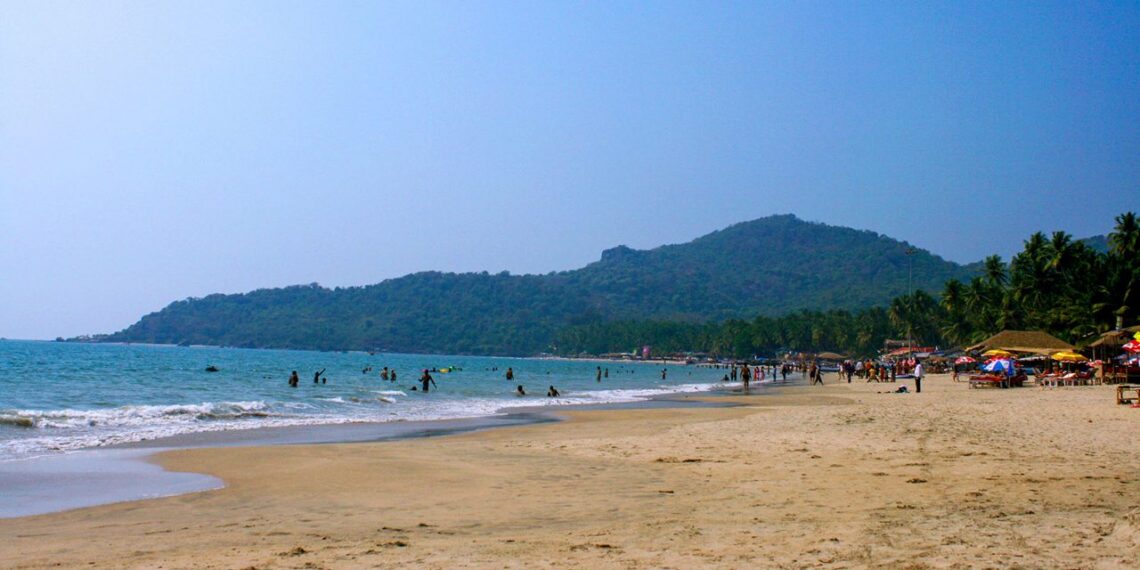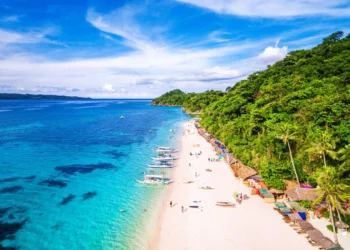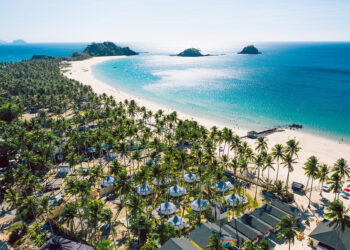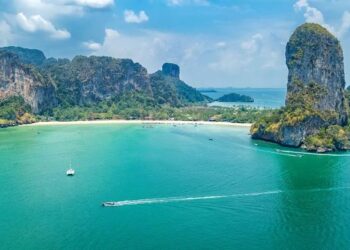Palolem Beach located in South Goa’s Canacona area is a quiet crescent shaped beach with features like soft white sand and gentle blue waters giving it quite a calm and serene vibe. It goes for about one and a half kilometers along the Arabian Sea and has palm trees and small green hills all around it.
Fun Fact About Palolem Beach
Palolem Beach is sometimes called “Paradise Beach” because of its beautiful and calm setting. It was even shown in the 2007 movie The Bourne Supremacy, letting people around the world see its natural charm. At the southern end of the beach, there is a small place called Canacona Island. At low tide, you can walk through shallow water to reach it, making it a quiet spot for exploring.
History of Palolem Beach
Palolem started as a quiet fishing village, home to Konkani-speaking locals who depended on the Arabian Sea and nearby rivers for fishing and daily life. Its name probably comes from a Marathi or Konkani word for a palm-lined shore, reflecting the many coconut trees in the area. During Portuguese rule (1510–1961), South Goa, including Palolem, was a small center for fishing and trade, though bigger ports like Vasco da Gama were more important.
The Cabo de Rama Fort, about 10 km from Palolem and built in the 1600s, still shows the area’s old colonial history.
In the 1980s, backpackers and hippies started coming to Palolem because it was quiet and beautiful, very different from the busy beaches in North Goa. Small temporary huts and shacks were made to host them. By the 1990s and 2000s, Palolem became known around the world as a peaceful alternative to party beaches like Calangute, with a chilled-out, bohemian vibe, yoga spots, and eco-friendly tourism.
Things to Do at Palolem Beach
Palolem Beach has lots to do for everyone, whether you want to relax, try water fun, or explore nature.
Relax on the Beach: The soft sand and calm sea are great for sunbathing, reading or even just lying under the palm shaded huts. Many shacks rent sunbeds and umbrellas.
Water Activities: Swimming is okay in marked areas, waves are quite gentle so beginners can even safely try. Kayaks, paddleboards, and dolphin-watching trips are offered, usually ₹500–₹1,500. Local fishermen sometimes take visitors on short fishing trips for a real local feel.
Yoga and Wellness: Many yoga centers are here, like Bhakti Kutir, offering daily classes on the beach or under trees (around ₹300–₹800). Ayurvedic massages and meditation sessions are also quite common.
Island and Nature Walks: At low tide you can walk to Canacona Island to explore or snorkel. Cotigao Wildlife Sanctuary is 12 km away, with trails where you may see langurs and rare birds.
Food and Nightlife: Some beach shacks like Cafe Del Mar serve local seafood, curries, and simple meals. Evenings sometimes have small bonfires and live music much quieter than the busy North Goa clubs.
Shopping: Along the beach, small stalls sell souviner things like handicrafts, sarongs, and silver jewelry. Chaudi Market, about 3 km away, has spices, cloth and fresh food, especially busy on Saturdays.
Nearby Places: You can go see Cabo de Rama Fort for views and history, or visit Agonda Beach, 8 km north, for a more quiet spot. A boat trip to Butterfly Beach (around ₹1,000–₹2,000) shows a hidden cove and marine life.
Best Time to Visit Palolem Beach
November to February
The weather is dry (around 22°C–32°C) with clear skies and calm seas, good for swimming, kayaking, or yoga. December sees the most visitors during Christmas and New Year, so it’s better to book huts early.
March to May
It gets hotter (28°C–36°C) but mornings are good for beach activities or indoor wellness sessions. There are fewer people, and hotel rates drop, though by May it can get quite humid.
June to October
Monsoon season (25°C–30°C) brings heavy rain, so water activities are limited. The surroundings become very green. Fewer tourists visit, making it really good time for budget stays and shacks are usually open for food and beverages.
Travel Tips
Water Safety: Usually the waves are calm but sometimes strong currents can happen. Better to swim near shacks where lifeguards are and avoid deep water during monsoon times.
Bargain: Always try to negotiate for boat trips, souvenirs, or taxis. Dolphin trips, for example, can go from ₹1,500 down to about ₹1,000. Keep cash handy because ATMs are few and sometimes can charge ₹20–₹50.
Sun Protection: Sun can be very strong. Use SPF 50+ cream, wear a hat and drink water very often. Best time to go is before 11 am or after 4 pm to avoid hottest hours.
Respect Nature: Use bins and don’t litter, or fines near ₹500. Don’t walk on dunes or disturb turtle nests (November–March). Support eco-friendly huts to help the beach stay natural.











